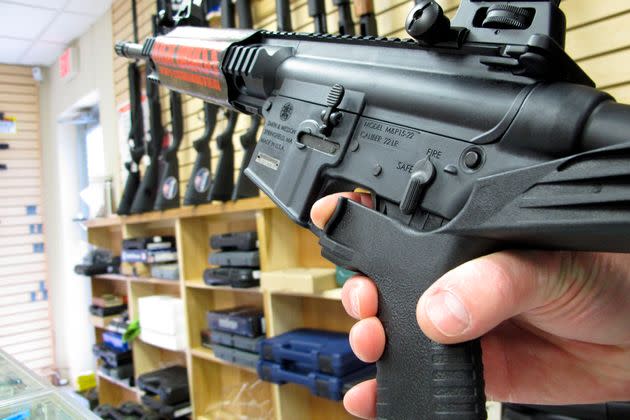Supreme Court Overturns Ban On Gun-Enhancing Bump Stock Devices
The Supreme Court Fridayoverturned a federal agency’s rule banning bump stocks, the devices used in some of America’s deadliest mass killings carried out by lone shooters.
In a 6-3 decision penned by Justice Clarence Thomas, the court found that the Bureau of Alcohol, Tobacco, Firearms and Explosives had exceeded its authority by reclassifying the devices as “machine guns” in response to an unprecedentedly violent mass shooting. The ruling will reopen America’s market for bump stocks after a six-year ban.
Plaintiff Michael Cargill, an Austin, Texas, gun store owner, did not claim that the Second Amendment protected his right to own a bump stock. The case focused narrowly on the administrative process by which the ATF banned bump stocks, which harness a firearm’s recoil to achieve rates of firing that approach those of automatic weapons.
The ATF issued a rule in 2018 reclassifying bump stocks as machine guns, making them illegal for civilians to own under federal law. The bureau passed the rule in response to the massacre at the Route 91 Harvest Music Festival in Las Vegas on Oct. 1, 2017, when a single shooter fired more than 1,000 rounds into a concert crowd, killing 60 people and injuring 850 more.
But the Supreme Court found that bump stocks did not meet the statutory definition of a “machine gun,” which requires that a gun fire automatically “by a single function of the trigger.”

“A bump stock does not convert a semiautomatic rifle into a machinegun any more than a shooter with a lightning-fast trigger finger does,” Justice Thomas wrote in an opinion speckled with illustrations documenting the workings of an AR-15 trigger.
The ATF had held in at least 10 separate instances before the Las Vegas shooting that affixing a bump stock to a semiautomatic weapon did not turn it into a machine gun, the opinion noted.
Thomas also described the ATF’s position on bump stocks as “logically inconsistent,” since a shooter can bump fire a semiautomatic weapon using their hands alone, but the agency does not classify bump-fired semiautomatic firearms as machine guns.
The court’s three liberal justices — Sonia Sotomayor, Elena Kagan and Katanji Brown Jackson — dissented, viewing bump stocks as similar enough to machine guns to warrant ATF’s 2018 reclassification.
“This is not a hard case,” Sotomayor wrote in a dissenting opinion. “All of the textual evidence points to the same interpretation. A bump-stock-equipped semiautomatic rifle is a machinegun because (1) with a single pull of the trigger, a shooter can (2) fire continuous shots without any human input beyond maintaining forward pressure.”
The ruling in Garland v. Cargill deals a heavy blow to gun reformers, who viewed a ban on bump stocks as a commonsense response to the deadliness such devices can wield in mass shootings.
“The majority of justices today sided with the gun lobby instead of the safety of the American people. This is a shameful decision,” Esther Sanchez-Gomez, litigation director of Giffords Law Center, wrote in an emailed statement. “Congress must act to undo the damage and make clear that bump stocks, and all automatic conversion devices, are illegal under federal law.”
But Friday’s ruling also highlighted the fragility of an agency-enacted ban that reformers had in many cases feared would not withstand judicial scrutiny.
After the Las Vegas shooting, a broad consensus formed that bump stocks, a small segment of the overall firearms industry, should be banned.
Congress, however, did not move swiftly to ban bump stocks in the aftermath of the Las Vegas shooting. Instead, then-President Donald Trump directed the ATF to restrict the devices.
The new Supreme Court ruling clarifies that Congress would have to impose the bump stock ban in order to remove the devices from the market.
“There is a simple remedy for the disparate treatment of bump stocks and machineguns,” Justice Samuel Alito wrote in a concurring opinion. “Congress can amend the law — and perhaps would have done so already if ATF had stuck with its earlier interpretation. Now that the situation is clear, Congress can act.”
Shortly after the ruling, Biden urged Congress to enact a ban, saying that “Americans should not have to live in fear of this mass devastation.”
“We know thoughts and prayers are not enough,” Biden’s statement said. “I call on Congress to ban bump stocks, pass an assault weapon ban, and take additional action to save lives — send me a bill and I will sign it immediately.”
But it remains to be seen whether such a measure can overcome the GOP’s historic opposition to gun reform in Congress, especially now that the sense of urgency following the Las Vegas shooting has dissipated.
Reporters asked Rep. Byron Donalds (R-Fla.), one of Trump’s biggest boosters in the House, if there would be any appetite for reviving Trump’s bump stock ban.
“No, I don’t think so,” Donalds said. “I think it’s probably going to be left where it is.”
Arthur Delaney contributed reporting.

